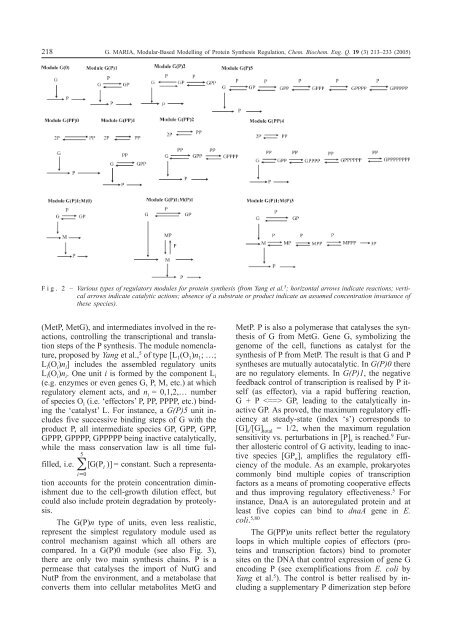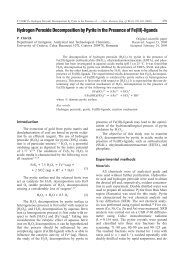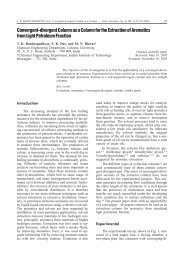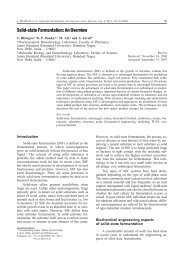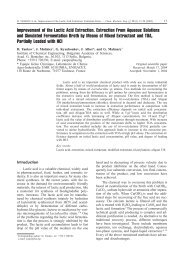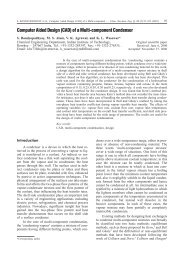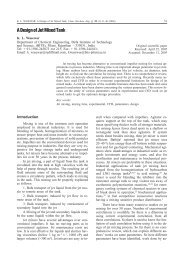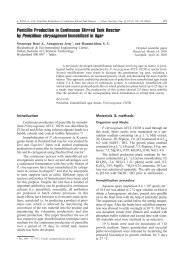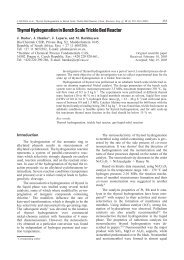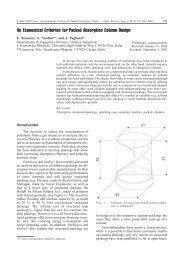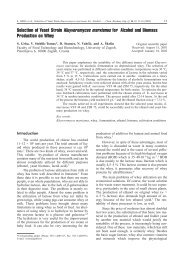Modular-Based Modelling of Protein Synthesis Regulation
Modular-Based Modelling of Protein Synthesis Regulation
Modular-Based Modelling of Protein Synthesis Regulation
Create successful ePaper yourself
Turn your PDF publications into a flip-book with our unique Google optimized e-Paper software.
218 G. MARIA, <strong>Modular</strong>-<strong>Based</strong> <strong>Modelling</strong> <strong>of</strong> <strong>Protein</strong> <strong>Synthesis</strong> <strong>Regulation</strong>, Chem. Biochem. Eng. Q. 19 (3) 213–233 (2005)<br />
Fig. 2 – Various types <strong>of</strong> regulatory modules for protein synthesis (from Yang et al. 5 ; horizontal arrows indicate reactions; vertical<br />
arrows indicate catalytic actions; absence <strong>of</strong> a substrate or product indicate an assumed concentration invariance <strong>of</strong><br />
these species).<br />
5<br />
<br />
(MetP, MetG), and intermediates involved in the reactions,<br />
controlling the transcriptional and translation<br />
steps <strong>of</strong> the P synthesis. The module nomenclature,<br />
proposed by Yang et al., 5 <strong>of</strong> type [L 1 (O 1 )n 1 ;…;<br />
L i (O i )n i ] includes the assembled regulatory units<br />
L i (O i )n i . One unit i is formed by the component L i<br />
(e.g. enzymes or even genes G, P, M, etc.) at which<br />
regulatory element acts, and n i = 0,1,2,… number<br />
<strong>of</strong> species O i (i.e. ‘effectors’ P, PP, PPPP, etc.) binding<br />
the ‘catalyst’ L. For instance, a G(P)5 unit includes<br />
five successive binding steps <strong>of</strong> G with the<br />
product P, all intermediate species GP, GPP, GPP,<br />
GPPP, GPPPP, GPPPPP being inactive catalytically,<br />
while the mass conservation law is all time fulfilled,<br />
i.e. [ GP ( i )] = constant. Such a representa-<br />
i0<br />
tion accounts for the protein concentration diminishment<br />
due to the cell-growth dilution effect, but<br />
could also include protein degradation by proteolysis.<br />
The G(P)n type <strong>of</strong> units, even less realistic,<br />
represent the simplest regulatory module used as<br />
control mechanism against which all others are<br />
compared. In a G(P)0 module (see also Fig. 3),<br />
there are only two main synthesis chains. P is a<br />
permease that catalyses the import <strong>of</strong> NutG and<br />
NutP from the environment, and a metabolase that<br />
converts them into cellular metabolites MetG and<br />
MetP. P is also a polymerase that catalyses the synthesis<br />
<strong>of</strong> G from MetG. Gene G, symbolizing the<br />
genome <strong>of</strong> the cell, functions as catalyst for the<br />
synthesis <strong>of</strong> P from MetP. The result is that G and P<br />
syntheses are mutually autocatalytic. In G(P)0 there<br />
are no regulatory elements. In G(P)1, the negative<br />
feedback control <strong>of</strong> transcription is realised by P itself<br />
(as effector), via a rapid buffering reaction,<br />
G + P GP, leading to the catalytically inactive<br />
GP. As proved, the maximum regulatory efficiency<br />
at steady-state (index ‘s’) corresponds to<br />
[G] s /[G] total = 1/2, when the maximum regulation<br />
sensitivity vs. perturbations in [P] s is reached. 9 Further<br />
allosteric control <strong>of</strong> G activity, leading to inactive<br />
species [GP n ], amplifies the regulatory efficiency<br />
<strong>of</strong> the module. As an example, prokaryotes<br />
commonly bind multiple copies <strong>of</strong> transcription<br />
factors as a means <strong>of</strong> promoting cooperative effects<br />
and thus improving regulatory effectiveness. 5 For<br />
instance, DnaA is an autoregulated protein and at<br />
least five copies can bind to dnaA gene in E.<br />
coli. 5,80<br />
The G(PP)n units reflect better the regulatory<br />
loops in which multiple copies <strong>of</strong> effectors (proteins<br />
and transcription factors) bind to promoter<br />
sites on the DNA that control expression <strong>of</strong> gene G<br />
encoding P (see exemplifications from E. coli by<br />
Yang et al. 5 ). The control is better realised by including<br />
a supplementary P dimerization step before


